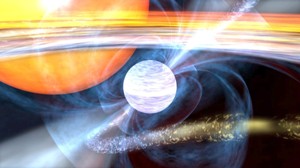Sep 27 2013
A fleet of orbiting X-ray telescopes that includes NASA's Swift orbiting observatory, which is controlled by Penn State, has been used by an international team of scientists in the discovery of a "millisecond pulsar" star with a dual identity.
In a feat that has never before been observed, the star readily shifts back and forth between two mutually exclusive styles of pulsed emissions -- one in X-rays, the other in radio waves. The discovery, the scientists say, reveals a long-sought intermediate phase in the life of these powerful objects.
 An illustration of how an old pulsar in a binary star system can be reactivated -- and sped up to a millisecond spin -- by gas falling onto it from its companion star. Image: NASA
An illustration of how an old pulsar in a binary star system can be reactivated -- and sped up to a millisecond spin -- by gas falling onto it from its companion star. Image: NASA
"Swift provided the first accurate, subarcminute localization of the X-ray burst, which allowed for the additional discovery of the pulsar's radio waves by the Australia Telescope Compact Array (ATCA)," said Jamie Kennea, a member of the Swift team at Penn State. The Swift spacecraft's science and flight operations are controlled by Penn State from the Mission Operations Center at University Park.
More information and an animation are online.
"This transitional object took us decades to find, and it provides us with a unique opportunity to observe a pulsar's intense magnetic field in action," said Sergio Campana, an astronomer at Brera Observatory in Merate, Italy, and a co-author of a paper on the object that appears in the Sept. 26 issue of the journal Nature.
What flips the switch from X-rays to radio waves and back is the rise and fall of gas streaming onto the pulsar from a normal companion star. A pulsar is a magnetized neutron star that emits regular pulses of light. A neutron star is the closest thing to a black hole that astronomers can observe directly, compressing half a million times Earth's mass into a ball no larger than a city. Once the core of a massive star that exploded as a supernova, a neutron star is so dense that a teaspoonful weighs as much as a mountain.
Millisecond pulsars combine incredible density and powerful magnetic fields with extreme rotation. The fastest one known whirls at 43,000 revolutions per minute. Astronomers think they achieve such speeds because these pulsars reside in binary systems with normal stars.
"Swift's Burst Alert Telescope was dynamically triggered by X-ray bursts from this star, which allowed its X-Ray Telescope to rapidly confirm the thermonuclear character of this explosion," said John Nousek, professor of astronomy and astrophysics and director of the Swift Mission Operations Center at Penn State.
Astronomers had expected the transformations in this type of star to occur on million-year timescales. But thanks to the international fleet of space-borne telescopes like the Swift satellite and support from many observatories on the ground, scientists now have uncovered the truth of IGR J18245-2452, the amazing quick-change artist among pulsars.